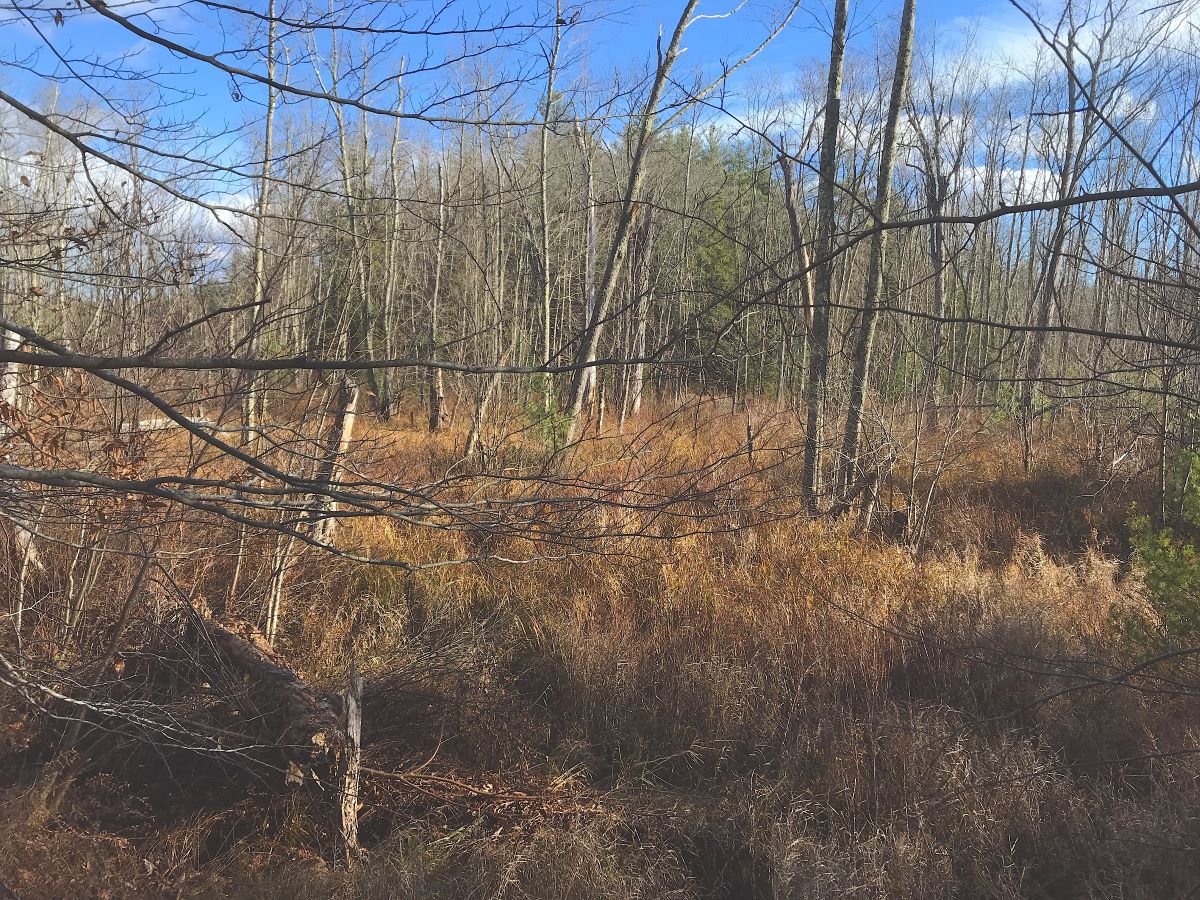Out in the Woods
- November 22nd 2024
- Out in the Woods

Sugarloaf Hill, as seen from Boivin Way Trail, 100 meters from the Sanford/Lebanon boundary.
Photo: Kevin McKeon
A Derailment Gave Sugarloaf Hill Its Name
By Kevin McKeon, Maine Master Naturalist
In 1794, Eli Whitney developed the cotton gin, which both increased production and enabled the use of lower quality, short-stapled cotton. This latter item led to the great expansion of southern cotton fields that supplied slave labor-produced cotton to his child labor-run mills in New England. He became known as the “Father of American Industrial Revolution,” and it’s this era that necessitated an advancement in transportation.
From pulling our stuff by foot in wagons, we evolved to the “Carriage Era,” and its many problems within burgeoning settlements. The budgets of city sanitation departments were being strained by the removal and disposition of dead horses by the thousands and manure by the tons. Roads had weight limitations and canals froze, thus transportation of heavy industrial machines and goods was exceedingly expensive and time-consuming. A mode of transportation for the increasingly growing manufactured goods sector was badly needed.
Beginning around 1820, railroads began their growth to become America’s big business, moving relaxed, socializing people and manufactured goods at a breakneck 15-20 mph to places inaccessible during the era of horse-powered transportation. Thus, the railroads came to Maine in 1836 with the Bangor to Old Town line, and in 1846 to Sanford via the York and Cumberland, the Portland and Rochester (1865), the Boston and Maine, and the Sanford and Eastern (1949) railroads.
Sanford’s Rail Trail is built on top of that rail bed, and what many folks may not realize is that this trail sits in the center of a 6-rod-wide parcel of land for most of its length. Some places are a bit narrower and some are wider, depending on what the railroad company needed and what the landowners were willing to part with. A rod is 16 ½ feet long, making the 6-rod width 99 feet, so the Rail Trail extends generally 49½ feet to either side of the center of the trail. Along Sanford’s beloved Rail Trail, there are many remnants, areas of interest, and stories relating to the historic railroad days.
A previous SSN article recalls the rail car that sank in Deering Pond’s peat bog in the spring of 1871. Another rail car sank too, within a couple of hundred feet of the Sanford/Lebanon boundary — and it’s a sweet story! This short account relating to the naming of Sugarloaf Hill was supplied by Nelson Ross and can be found in the Lebanon Historical Society’s 1992 publication, “The Railroad, Lebanon, Maine; In Retrospect.”
“When Nelson Ross was a young boy, Albert Goodwin told him that years ago a railroad car loaded with sugar tipped over in the bog area beyond the overpass near Wilbur Woodman’s, where it sank out of sight, That, Goodwin said, was the reason why the large knoll near this spot, thereafter was called Sugarloaf.”
The “overpass near Wilbur Woodman’s” was called Goodwin’s Bridge. There are no apparent remnants of this bridge, which according to the above publication was located at the intersection of what is now Red Smith Road and Blanchard Road. Modifications to the bridge were required to provide clearances for the brakemen, who rode on top of rail cars.
“Where said Railroad cuts through Highway over Smith’s Hill (Smith Road) in said town, there shall be built by said (railroad company) a bridge over said Railroad not less than 18 feet wide. The Northeast corner of the Bridge shall be of sufficient width to make a proper turn for the crossroad, (Blanchard Road) and the fill at the South end of the bridge shall be of equal width with the Bridge, and said Bridge and filling shall be properly railed, and grading and filling shall be sufficiently done for public travel. (Goodwin’s Bridge), near Wilbur Woodman’s”.
Another reference for Sugarloaf Hill is available at Mousam Way Land Trust’s description of its property, Boivin Way, an extension of the Rail Trail beginning at the Sanford/Lebanon boundary:
“Near the end of the 1800s, a freight car loaded with sugar derailed and sank out of sight in a bog at the Sanford-Lebanon line. A conical knoll of rocky glacial till just within Lebanon marks the spot and has come to be known as “Sugar Loaf Hill.”
So, as we walk along the Rail Trail, about 130 feet into Lebanon, a gander to the southeast will offer a view of Sugarloaf Hill, and somewhere in the reeds lies a sweet rail car!
Editor’s note: Did you see something unusual last time you were out in the woods? Were you puzzled or surprised by something you saw? Ask our “Out in the Woods” columnist Kevin McKeon. He’ll be happy to investigate and try to answer your questions. Email him directly at: kpm@metrocast.net






